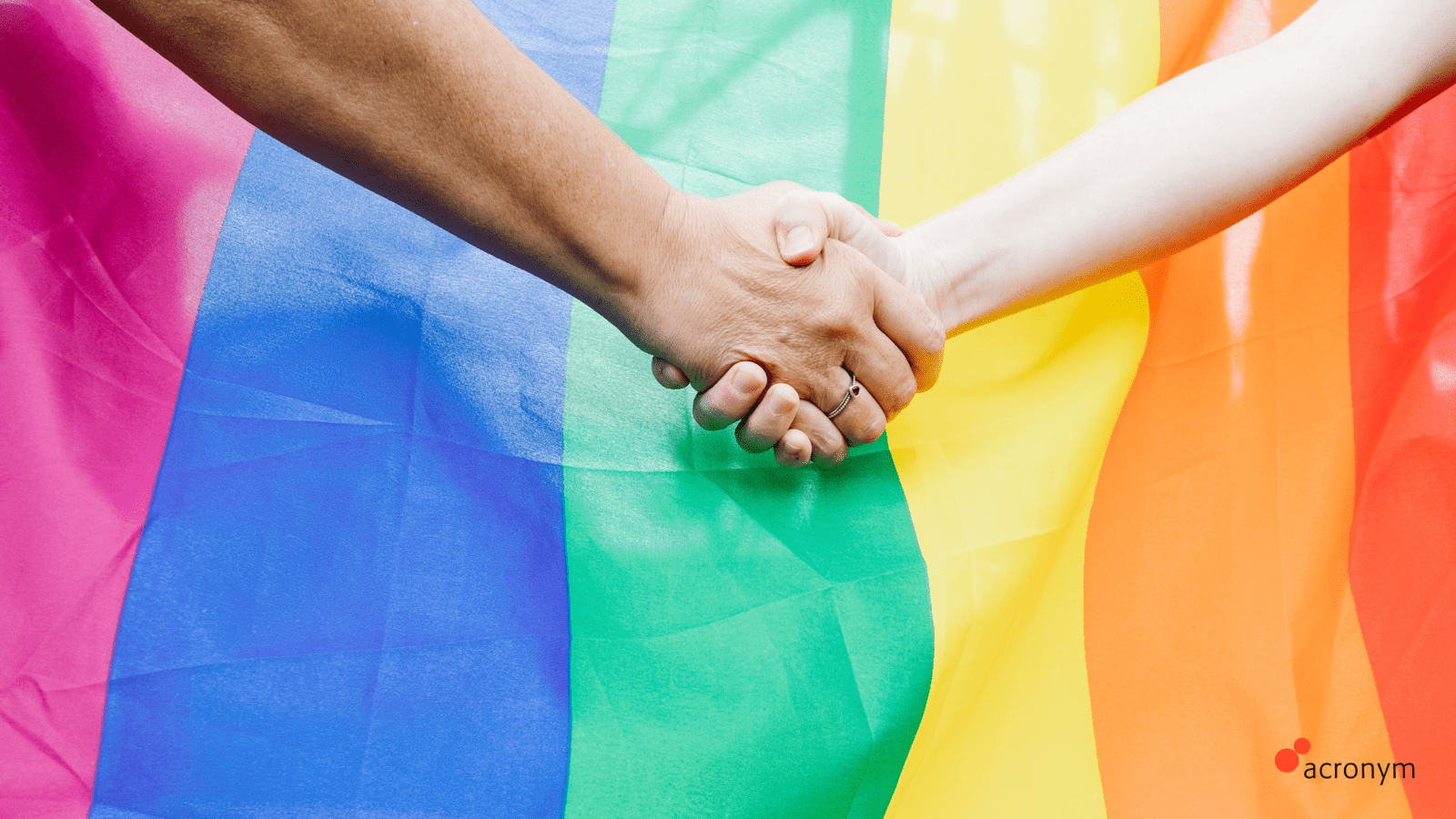As Pride Month comes to a close, Acronym’s Chief People & Diversity Officer, Irwin Drucker shares his perspective on why PRIDE matters.
Many of my friends, both LGBTQ and not, have asked me why, in the post Obergefell v Hodges era, there is still the need to celebrate PRIDE. I have given them very long-winded explanations and then, this past Saturday, I came across this graphic, which absolutely NAILS IT!

I realized that I was gay while in Junior High School, came out to my first friend while in college, and to my family when I was 26, and already living in South Florida. I was one of the extremely fortunate gay men who was raised in a family where your sexuality was not an issue to anyone. Even my 80+ year old grandmother welcomed and adored my first partner, Jerry (although, to be honest, she referred to him as “my brother”, so I’m not 100% sure she really understood the situation). For gay men of my generation, the AIDS epidemic was our cause, as many fought, and lost, the battle for their lives. And while the Federal government was woefully inadequate in its response to the crisis, the epidemic brought the community together as nothing ever had, with non-profits filled the gap and organizations like GMHC, AHF, Act UP, the Elizabeth Taylor AIDS Foundation, amfAR, Broadway Cares/Equity Fights AIDS, the Elizabeth Glaser Pediatric AIDS Foundation, APLA, and so many more, became household words.
When the crisis stabilized, the LGBT rights movement began to gain strength. Collectively, the LGBTQ community, and millions of our amazing Allies, clearly saw that many in government, at the Federal, state, and local levels, saw us as “less than”, and not deserving of the equal rights that had been granted to ALL American citizens by the Constitution. For those of us lucky enough to live in “an LGBT bubble” like New York City, Miami/Fort Lauderdale, Los Angeles, or other similar LGBT population centers, things seemed pretty good on the surface. But for our brothers and sisters in more rural areas of our country, being LGBT was a nightmare. Each year, countless LGBT youth were thrown out of their homes by families unwilling to accept the fact that their sons and daughters were homosexual. Even more LGBT youth were forced to live life in the closet, repressing their sexuality in order to “fit in” at home, school, and place of worship. For all of these young men and women, there was one day that gave them hope … and that day was PRIDE.
When I went to my first PRIDE parade, in Fort Lauderdale, with Jerry, in 1986, the AIDS epidemic was just beginning. Fort Lauderdale was definitely not the gay mecca it is today. Wilton Manors still had remnants of its trailer park past, the mayor was not a friend of the LGBT community, and law enforcement still conducted random raids on parks known to be frequented by gay men. But on that Sunday in June, as the parade marched past me and turned into War Memorial Auditorium for that year’s PRIDEFest, I felt like my community owned the city. It was an amazing feeling. I never dreamt that a year later, Jerry would be diagnosed with AIDS, and I would begin my activist journey.
PRIDE became a sacred day on my calendar. And the LGBT Equal Rights movement became my new cause. The decades of the 1980s and 90s saw a number of Supreme Court cases that focused on LGBT rights, and the results were mixed. We had our first victory in Romer v. Evans in 1996, but big losses in Bowers v. Hardwick (1986) and Boy Scouts of America v. Dale (also in 1996), and, of course, 1996 also was the year that the Defense of Marriage Act (DOMA) was signed into law, banning same-sex marriage rights at the Federal level. And in 1998, in rural Wyoming, Matthew Shepard was beaten, tortured, and left to die tied to a barbed wire fence on a freezing cold night. During these bleak years, PRIDE was the only day of the year it seemed to be OK to be LGBT.
It wasn’t until 2004, in the State of Massachusetts, that same-sex marriage was first legalized in the US. As the years passed, more and more states passed laws banning same-sex marriage, while a few passed laws which allowed it. And every year, at PRIDE, we celebrated the few victories we had achieved over the past year, and looked forward to the day when we would be seen as equal before the law in every respect. The pace really picked up in the 2010s. In 2013, in it’s most pro-LGBTQ ruling to that date, the SCOTUS, in United States v. Windsor, ruled that DOMA was unconstitutional. As if that wasn’t exciting enough, two years later came the landmark case of Obergefell v. Hodges, which made same-sex marriage legal in all 50 states!! We sure celebrated at PRIDE in 2015!!
So we are back at the beginning … why, since 2015, have we needed to keep celebrating PRIDE? Haven’t we achieved everything we set out to accomplish since the Stonewall riots in 1969 kick-started the LGBT Rights movement? In a word, NO. Although we won the right to marry the person we love, irrespective of their gender, we lost the next time “we” were at the Supreme Court. In 2018, in Masterpiece Cakeshop v. Colorado Civil Rights Commission, the SCOTUS ruled that an individual’s religious beliefs could not be ignored in the interest of promoting equality. This has created a huge loophole through which countless instances of homophobia have been allowed to go unchecked under the guise of “religious liberties.” And even with the most recent landmark ruling in our favor in 2020, when the SCOTUS ruled that discrimination based upon gender identity of sexual orientation violates Title VII of the Civil Rights Act of 1964, which prohibits employers from discriminating against their employees on the basis of sex, race, color, national origin and religion, the fight for equality continues. And so does the need for PRIDE.

Why, you ask?? Every year in our great country, over 4 MILLION youth experience homelessness, for a variety of reasons. And yet, according to True Colors United, 40% of those youth are LGBTQ, while only 7% of all youth are LGBTQ.
In addition, according to groups like Trevor Project, more than 10% of LGBTQ youth have attempted suicide, and that number skyrockets to more than 30% of Trans youth. And 42% of LGBTQ youth seriously considered attempting to take their own lives! That’s an estimated 1.8 million young people who are seriously considering taking their own lives rather than continuing to live as an LGBTQ person!
So that, my friends, is why we still need PRIDE. As an out and proud gay man, I am fortunate to be part of a family and to work for a company with a culture that embraces me for who I am. Until ALL of my LGBTQ brothers and sisters can say the same thing, we will still need to have PRIDE, so that every young LGBTQ man and woman can know that there is hope, that it’s okay to be LGBTQ, and that they can dare to dream to be anything they choose.
As a LGBT-owned agency, Acronym is a proud member of the NGLCC. To learn more about our own Diversity and Inclusion programs, please contact us.










